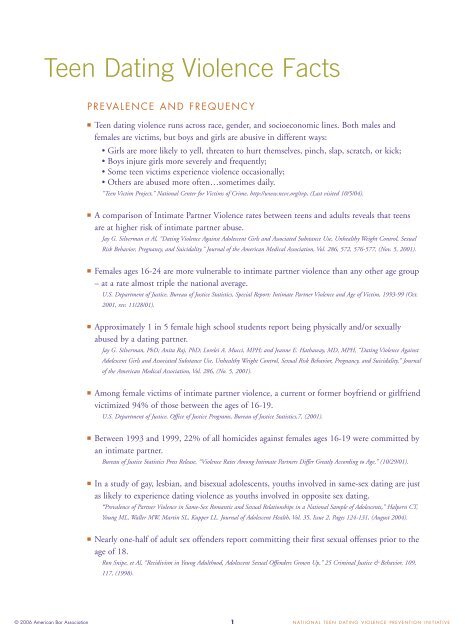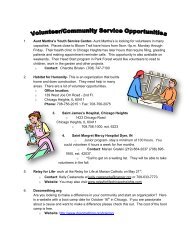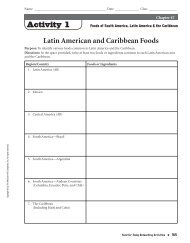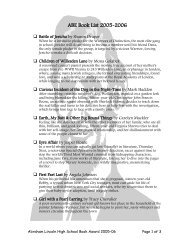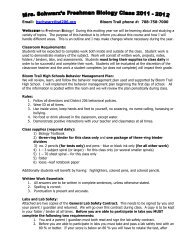Teen Dating Violence Facts - Bloom Trail High School
Teen Dating Violence Facts - Bloom Trail High School
Teen Dating Violence Facts - Bloom Trail High School
You also want an ePaper? Increase the reach of your titles
YUMPU automatically turns print PDFs into web optimized ePapers that Google loves.
<strong>Teen</strong> <strong>Dating</strong> <strong>Violence</strong> <strong>Facts</strong><br />
PREVALENCE AND FREQUENCY<br />
■ <strong>Teen</strong> dating violence runs across race, gender, and socioeconomic lines. Both males and<br />
females are victims, but boys and girls are abusive in different ways:<br />
• Girls are more likely to yell, threaten to hurt themselves, pinch, slap, scratch, or kick;<br />
• Boys injure girls more severely and frequently;<br />
• Some teen victims experience violence occasionally;<br />
• Others are abused more often…sometimes daily.<br />
“<strong>Teen</strong> Victim Project,” National Center for Victims of Crime, http://www.ncvc.org/tvp, (Last visited 10/5/04).<br />
■ A comparison of Intimate Partner <strong>Violence</strong> rates between teens and adults reveals that teens<br />
are at higher risk of intimate partner abuse.<br />
Jay G. Silverman et Al, “<strong>Dating</strong> <strong>Violence</strong> Against Adolescent Girls and Associated Substance Use, Unhealthy Weight Control, Sexual<br />
Risk Behavior, Pregnancy, and Suicidality.” Journal of the American Medical Association, Vol. 286, 572, 576-577, (Nov. 5, 2001).<br />
■ Females ages 16-24 are more vulnerable to intimate partner violence than any other age group<br />
– at a rate almost triple the national average.<br />
U.S. Department of Justice, Bureau of Justice Statistics, Special Report: Intimate Partner <strong>Violence</strong> and Age of Victim, 1993-99 (Oct.<br />
2001, rev. 11/28/01).<br />
■ Approximately 1 in 5 female high school students report being physically and/or sexually<br />
abused by a dating partner.<br />
Jay G. Silverman, PhD; Anita Raj, PhD; Lorelei A. Mucci, MPH; and Jeanne E. Hathaway, MD, MPH, “<strong>Dating</strong> <strong>Violence</strong> Against<br />
Adolescent Girls and Associated Substance Use, Unhealthy Weight Control, Sexual Risk Behavior, Pregnancy, and Suicidality,” Journal<br />
of the American Medical Association, Vol. 286, (No. 5, 2001).<br />
■ Among female victims of intimate partner violence, a current or former boyfriend or girlfriend<br />
victimized 94% of those between the ages of 16-19.<br />
U.S. Department of Justice, Office of Justice Programs, Bureau of Justice Statistics,7, (2001).<br />
■ Between 1993 and 1999, 22% of all homicides against females ages 16-19 were committed by<br />
an intimate partner.<br />
Bureau of Justice Statistics Press Release, “<strong>Violence</strong> Rates Among Intimate Partners Differ Greatly According to Age,” (10/29/01).<br />
■ In a study of gay, lesbian, and bisexual adolescents, youths involved in same-sex dating are just<br />
as likely to experience dating violence as youths involved in opposite sex dating.<br />
“Prevalence of Partner <strong>Violence</strong> in Same-Sex Romantic and Sexual Relationships in a National Sample of Adolescents,” Halpern CT,<br />
Young ML, Waller MW, Martin SL, Kupper LL. Journal of Adolescent Health, Vol. 35, Issue 2, Pages 124-131, (August 2004).<br />
■ Nearly one-half of adult sex offenders report committing their first sexual offenses prior to the<br />
age of 18.<br />
Ron Snipe, et Al, “Recidivism in Young Adulthood, Adolescent Sexual Offenders Grown Up,” 25 Criminal Justice & Behavior, 109,<br />
117, (1998).<br />
© 2006 American Bar Association 1 NATIIONAL TEEN DATING VIOLENCE PREVENTION INITIATIVE
■ 58% of rape victims report being raped between the ages of 12-24.<br />
Health Resources and Services Administration (HRSA), Maternal and Child Health Bureau, U.S. Department of Health and<br />
Human Services (HHS), (2002).<br />
■ Half of the reported date rapes occur among teenagers.<br />
California Coalition Against Sexual Assault (CALCASA) 2002 Report: Research on Rape and <strong>Violence</strong>,<br />
http://www.uasasonoma.org/teensite/statistics.htm#Child/<strong>Teen</strong>%20Vicitmization, (Last Visited 10/1/04).<br />
■ Intimate partner violence among adolescents is associated with increased risk of substance use,<br />
unhealthy weight control behaviors, sexual risk behaviors, pregnancy, and suicide.<br />
Molidor, Tolman, & Kober, (2000); National Center for Injury Prevention and Control, (2001).<br />
PARENTAL AWARENESS<br />
■ 81% of parents surveyed either believe teen dating violence is not an issue or admit they don’t<br />
know if it’s an issue.<br />
“Women’s Health,” June/July 2004, Family <strong>Violence</strong> Prevention Fund and Advocates for Youth,<br />
http://www.med.umich.edu/whp/newsletters/summer04/p03-dating.html, (Last visited 9/23/04).<br />
■ A majority of parents (54%) admit they’ve not spoken to their child about dating violence.<br />
Empower Program, sponsored by Liz Claiborne Inc. and conducted by Knowledge Networks, Social Control, Verbal Abuse, and<br />
<strong>Violence</strong> Among <strong>Teen</strong>agers, (2000).<br />
TEEN AWARENESS<br />
■ Nearly 25% of 14-17 year-olds surveyed know at least one student who was a victim of dating<br />
violence, while 11% know multiple victims of dating violence. 33% of teens have actually witnessed<br />
such an event.<br />
Empower Program, sponsored by Liz Claiborne Inc. and conducted by Knowledge Networks, Social Control, Verbal Abuse, and<br />
<strong>Violence</strong> Among <strong>Teen</strong>agers, (2000).<br />
■ 20% of surveyed male students report witnessing someone they go to high school with physically<br />
hit a person they were dating.<br />
Tiffany J. Zwicker, Education Policy Brief, “The Imperative of Developing <strong>Teen</strong> <strong>Dating</strong> <strong>Violence</strong> Prevention and Intervention<br />
Programs in Secondary <strong>School</strong>s.” 12 Southern California Review of Law and Women’s Studies, 131, (2002).<br />
■ 39% of female high school students report that students talk in school about whether someone<br />
is attempting to control the person they are dating.<br />
Tiffany J. Zwicker, Education Policy Brief, “The Imperative of Developing <strong>Teen</strong> <strong>Dating</strong> <strong>Violence</strong> Prevention and Intervention<br />
Programs in Secondary <strong>School</strong>s.” 12 Southern California Review of Law and Women’s Studies, 131, (2002).<br />
© 2006 American Bar Association 2 NATIIONAL TEEN DATING VIOLENCE PREVENTION INITIATIVE
■ 57% of teens know someone who has been physically, sexually, or verbally abusive in a dating<br />
relationship.<br />
Liz Claiborne Inc., Conducted by <strong>Teen</strong>age Research Unlimited, (February 2005).<br />
■ 45% of girls know a friend or peer who has been pressured into either intercourse or oral sex.<br />
Liz Claiborne Inc., Conducted by <strong>Teen</strong>age Research Unlimited, (February 2005).<br />
■ One in three teens reports knowing a friend or peer who has been hit, punched, kicked,<br />
slapped or physically hurt by their dating partner.<br />
Liz Claiborne Inc., Conducted by <strong>Teen</strong>age Research Unlimited, (February 2005).<br />
■ In 9 out of 10 rapes in which the offender is under 18, so is the victim.<br />
Health Resources and Services Administration (HRSA), Maternal and Child Health Bureau, U.S. Department of Health and<br />
Human Services (HHS), Fact Sheet on <strong>Violence</strong>: Adolescents & Young Adults, 5, (2002).<br />
INCIDENT REPORTING<br />
■ When female high school students were asked whom they would talk to if someone they date<br />
is attempting to control them, insults them, or physically harms them, 86% percent said they<br />
would confide in a friend, while only 7% said they would talk to police.<br />
Tiffany J. Zwicker, Education Policy Brief, “The Imperative of Developing <strong>Teen</strong> <strong>Dating</strong> <strong>Violence</strong> Prevention and Intervention<br />
Programs in Secondary <strong>School</strong>s.” 12 Southern California Review of Law and Women’s Studies, 131, (2002).<br />
■ 83% of 10th graders surveyed at the 4th Annual <strong>Teen</strong> <strong>Dating</strong> Abuse Summit reported that<br />
they would sooner turn to a friend for help with dating abuse than to a teacher, counselor,<br />
parent or other caring adult.<br />
The Northern Westchester Shelter, with Pace Women’s Justice Center, (April 2003).<br />
■ Only 33% of teens who were in an abusive relationship ever told anyone about the abuse<br />
Liz Claiborne Inc., Conducted by <strong>Teen</strong>age Research Unlimited, (February 2005).<br />
CONTRIBUTING FACTORS<br />
■ A study of 1,600 juvenile sexual assault offenders nationwide indicated that only around 33%<br />
of the juveniles perceived sex as a way to demonstrate love or caring for another person;<br />
23.5% percent perceived sex as a way to feel power and control; 9.4% as a way to dissipate<br />
anger; 8.4% percent as a way to punish.<br />
California Coalition Against Sexual Assault (CALCASA) 2002 Report: Research on Rape and <strong>Violence</strong>,<br />
http://www.uasasonoma.org/teensite/statistics.htm#Child/<strong>Teen</strong>%20Vicitmization, (Last visited 10/1/04).<br />
© 2006 American Bar Association 3 NATIIONAL TEEN DATING VIOLENCE PREVENTION INITIATIVE
■ A University of Texas medical center study of new mothers, age 18 and younger, chronicled<br />
numerous reports of being slapped, hit, kicked or physically hurt by a husband or boyfriend.<br />
Most of the violent incidents occurred during the first three months after childbirth.<br />
S. Harrykissoon, M.P.H., V. Rickert, Psy.D. and C. Wiemann, Ph.D, (2002).<br />
■ Both victims and abusers attribute the responsibility for violent dating behavior to victims,<br />
caused by: provocation by the girl; the victim’s personality type; the girl’s need for affection;<br />
communication problems; and peer group influence.<br />
Francine Lavoie et Al, <strong>Teen</strong> <strong>Dating</strong> Relationships and Aggression, (2002).<br />
■ 77% of female and 67% of male high school students endorse some form of sexual coercion,<br />
including unwanted kissing, hugging, genital contact, and sexual intercourse.<br />
M. Jackson, F. Cram & F.W. Seymour, Journal of Family <strong>Violence</strong>, (2000).<br />
■ Male peer support for violence against women is a constant predictor of male violence within<br />
post-secondary educational institutions.<br />
Martin D. Schwartz & Walter S. DeKerrseredy, “Aggregation Bias and Woman Abuse,” (2000).<br />
■ 50% of youth reporting both dating violence and rape also reported attempting suicide, compared<br />
to 12.5% of non-abused girls and 5.4% of non-abused boys.<br />
D. M. Ackard, Minneapolis, MN, and D. Neumark-Sztainer, Division of Epidemiology, <strong>School</strong> of Public Health, University of<br />
Minnesota, Minneapolis, MN, “Date <strong>Violence</strong> and Date Rape Among Adolescents: Associations with Disordered Eating Behaviors and<br />
Psychological Health,” Child Abuse & Neglect, 26 455-473, (2002).<br />
THE LEGACY OF RELATIONSHIP ABUSE<br />
■ More than half of both prison and jail inmates serving time for violence against an intimate<br />
were using drugs, alcohol or both at the time of the incident for which they were incarcerated.<br />
U.S. Department of Justice, http://www.ojp.usdoj.gov/bjs/pub/press/vi.pr, (1998). (Last visited 9/04.)<br />
■ The severity of violence among intimate partners has been shown to increase if the pattern has<br />
been established in adolescence.<br />
S.L. Feld & M.A. Strauss, Criminology, 27, 141-161, (1989).<br />
■ Patterns of dating violence behavior often start early and carry through into adult<br />
relationships.<br />
V.A. Forshee et Al, Health Education Research, 11(3), 275-286, (1996).<br />
■ Violent relationships in adolescence can have serious ramifications for victims: Many will continue<br />
to be abused in their adult relationships and are at a higher risk for substance abuse, eating<br />
disorders, risky sexual behavior, and suicide.<br />
Jay G. Silverman PhD, et Al, “<strong>Dating</strong> <strong>Violence</strong> Against Adolescent Girls and Associated Substance Use, Unhealthy Weight Control,<br />
Sexual Risk Behavior, Pregnancy, and Suicidality.” Journal of the American Medical Association, (2001).<br />
© 2006 American Bar Association 4 NATIIONAL TEEN DATING VIOLENCE PREVENTION INITIATIVE


